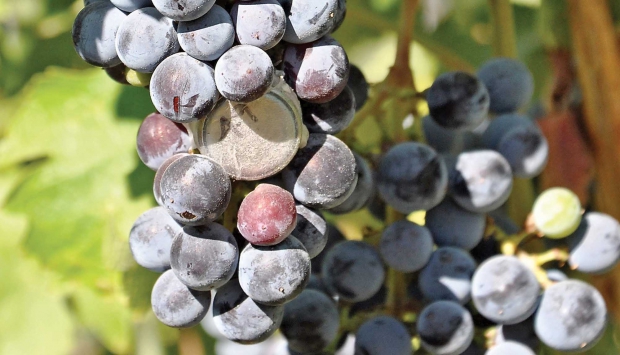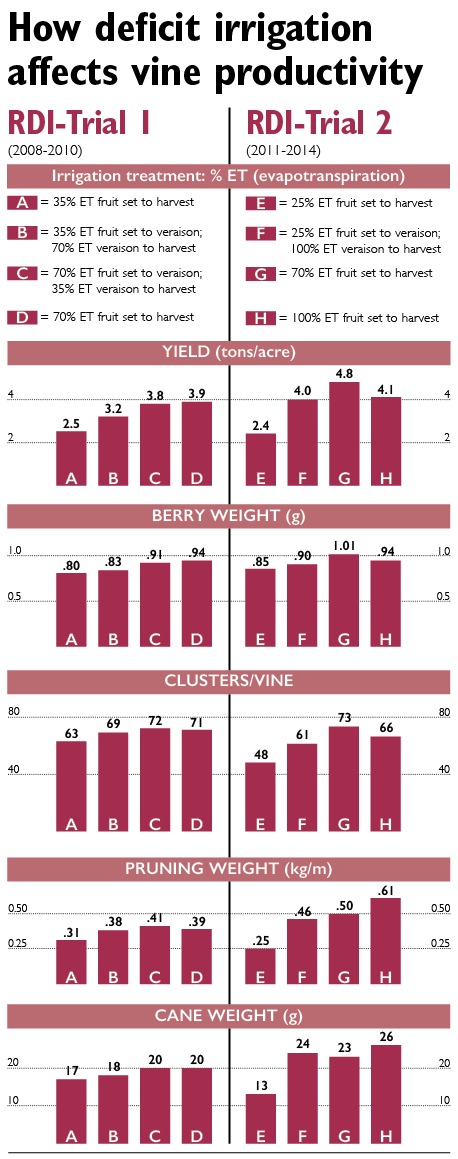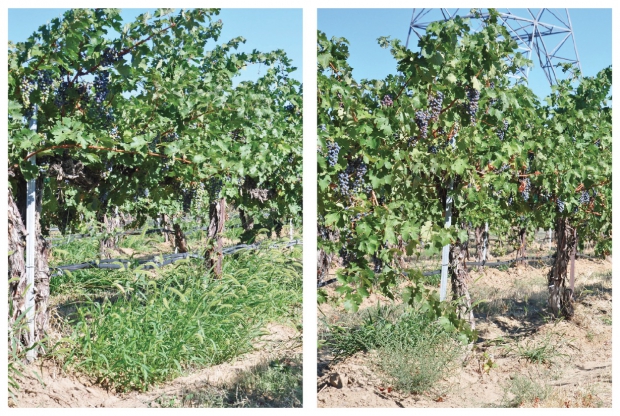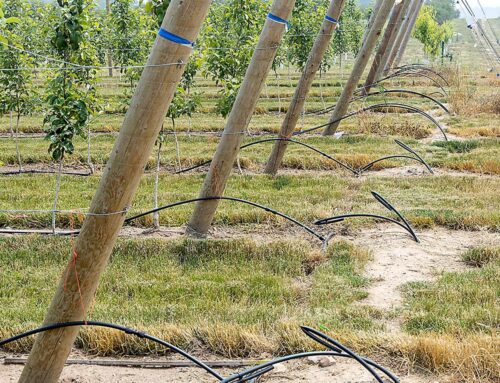
iButtons, as shown in the bottom portion of this cluster, were used to record temperatures of sun-exposed and shaded grape clusters in the 25 percent ET and 100 percent ET strategies. Temperatures up to 120°F were recorded in the sun-exposed clusters in the 25 ET treatment compared to around 100°F on the same day in the 100 percent ET vines. (Courtesy Markus Keller)
Timing is everything when applying regulated deficit irrigation in red wine grape vineyards in Washington State.

Pre-veraison deficit irrigation had smaller berries and less dense canopy, without negatively impacting yields. Source: Dr. Markus Keller, WSU (Jared Johnson/Good Fruit Grower illustration)
New research shows the importance of the timing of plant water stress and suggests that growers could apply even less water than current industry deficit irrigation standards without negative effects.
In the last 25 years, regulated deficit irrigation (RDI) has become the norm for most wine grape varieties grown in eastern Washington. Much of the early research on RDI by Washington State University focused on white varieties.
RDI is a controlled seasonal water deficit strategy that applies less water than the vineyard evaporates or needs, says Dr. Markus Keller, WSU horticulturist who specializes in grapevine physiology.
When used properly, it allows growers to limit shoot growth, develop a more open and less dense canopy, and results in small berries and lower yields, improving fruit quality. In white varieties, berry size is not as important and there can be too much exposure of the fruit to sunlight, thus, WSU is revisiting the RDI approach for whites.
With RDI, plant water deficits are caused by letting the soil moisture drop below full grapevine evapotranspiration after bloom. Water is then carefully applied during the deficit window, usually after fruit set to veraison or harvest.
Evapotranspiration is the combination of evaporation of water from the soil surface and transpiration of water through the plant’s leaves, and together, represent the crop’s water use.
RDI involves understanding evapotranspiration (ET) rates and crop coefficients of the vine, monitoring soil moisture, and tailoring plant stress to individual vineyards. WSU’s AgWeatherNet service can help growers schedule irrigation based on ET and predicted weather.
Keller, in cooperation with WSU enologist Dr. James Harbertson and Ste. Michelle Wine Estates, completed six years of research in 2014 that studied the timing of more severe deficit irrigation regimes than the current industry standard. Many growers apply about 60 to 70 percent of ET between fruit set and harvest.
Ste. Michelle Wine Estates varied water amounts at different timings in an ultra-premium Cabernet Sauvignon block at their Cold Creek Vineyard. The project investigated the physiological and viticultural effects on the vines and also analyzed wine chemistry and sensory differences of wines made from the different treatments.
The project included two trials covering 2008 to 2010 and 2011 to 2014. Luckily for researchers, each trial included warm, cool, and average seasons, which allowed the same irrigation treatments to be studied under different conditions.
Cold Creek Vineyard was planted in 1981, with a vine spacing of seven-by-ten feet in a north-south row orientation.
Vines are spur-pruned and trained to a loose vertical shoot positioned system.
In the first trial, from 2008 to 2010, irrigation treatments were:
—70 percent ET from fruit set to harvest (industry standard)
—35 percent ET from fruit set to veraison, 70 percent ET from veraison to harvest
—70 percent ET from fruit set to veraison, 35 percent ET from veraison to harvest
—35 percent ET from fruit set to harvest
More extreme irrigation treatments were studied in the second trial:
—100 percent ET from fruit set to harvest
—60 to 70 percent ET from fruit set to harvest (industry standard)
—25 percent ET from fruit set to harvest
—25 percent ET from fruit set to veraison, 100 percent ET from veraison to harvest
Timing
In both trial sets, irrigation effects were consistent over the three years, said Keller, who shared results during the annual meeting of the Washington Association of Wine Grape Growers.
Vine growth and productivity were measured by collecting data on leaf layers at veraison, pruning weight, cane weight, yield, cluster numbers per vine, and berry weight.
Some of the research findings were expected, others more interesting.
“Full-season deficit of 25 or 35 percent ET led to lower vigor and yield,” he said. In both trials, yields of the full season 25 and 35 percent ET were half to a third (2.4 and 2.5 tons per acre, respectively) lower than the industry standard of 4.8 and 3.9 tons per acre, respectively.
“Pre-veraison deficit of 25 or 35 percent and then watering 70 or 100 percent after veraison resulted in smaller berries—what winemakers want—without significantly reducing yield,” he said.
Interestingly, researchers found no difference between applying 70 or 35 percent ET from veraison to harvest.
“There was no effect from cutting the post-veraison water supply in half,” said Keller, noting that reducing irrigation after veraison to reduce berry size was ineffective. “So if you think you can correct any overwatering done early in the season by applying deficit after veraison, it won’t work.
“Conversely, increasing irrigation after veraison following a pre-veraison deficit did not increase berry size. So the fear of many winemakers that late-season irrigation somehow dilutes quality is unjustified.”
Impacts on weed growth and cluster sun exposure are additional benefits of RDI. Keller observed significant reduced weed growth in the 25 percent ET treatment compared with 100 percent ET. Also, there were fewer shadows under the canopy in the deficit treatment, which indicates the canopy is more open and clusters more exposed to light.
Light exposure is needed to bring out flavor qualities of fruit and eliminate vegetative or “green” flavors. But too much heat and solar radiation can sunburn berries and impair color accumulation.
Keller used small devices called iButtons to monitor temperatures of sun-exposed and shaded clusters in the 25 and 100 percent ET treatments throughout the season. Temperatures of up to 120°F were recorded in sun-exposed clusters in the 25 percent ET before veraison.
“There is such a thing as too much fruit exposure caused by having such a small canopy from the season-long deficit irrigation.”
Some stress is good and can achieve desired results, but more is not necessarily better.
“The extreme deficit of 25 percent ET all season long is too much water stress and simply not enough water for Cabernet Sauvignon,” Keller said. “The 25 percent ET decreased almost everything we measured. There was a loss of vine capacity, loss of productivity, and excessive fruit exposure. It’s not sustainable for Cabernet.”
Keller was not surprised that vines did well in the 35/70 percent ET regime (35 percent ET fruit set to veraison/70 percent ET veraison to harvest). He was a little more surprised by how well they did with the 25/100 percent ET. “It seems that 35 percent ET is as low as you can go over the berry development period,” he said.
“Though 25 percent ET is too much water deficit if you apply it for the entire period, if you start out with low water amounts from fruit set to veraison and then increase water, you get all the benefits,” he said. “You get small berries, an open canopy, which helps with disease control and weed control, and good sun exposure, all while maintaining vine capacity with no decline in vine productivity.” •
ONLINE
Learn more about evapotranspiration and irrigation scheduling at: www.wine.wsu.edu, www.irrigation.wsu.edu, or www.weather.wsu.edu

A side benefit of regulated deficit irrigation is weed control. Notice the abundance of weeds in the left photo (100 percent ET) compared to the lack of weeds in the 25 percent ET vines on the right. (Courtesy Markus Keller)
—–
Deficit irrigation guidelines
General guidelines to follow when applying regulated deficit irrigation regimes to wine grapes:
—Avoid early season stress, which negatively impacts fruit set (this year’s crop) and bud fruitfulness (next year’s crop).
—Avoid giving excess water in mid-season, which results in larger berries and a bigger canopy.
—Avoid late season stress, which shrivels and dehydrates berries and reduces tonnage.
If applying RDI to red wine grape varieties, do it early—before veraison. Don’t wait for post-veraison or you will have no beneficial effect, says Dr. Markus Keller, Washington State University horticulturist.






You mentioned “The project … and also analyzed wine chemistry and sensory differences of wines made from the different treatments.” But I didn’t see any discussion concerning the real and percieved differences in the wines produced from the varied treatments. ??